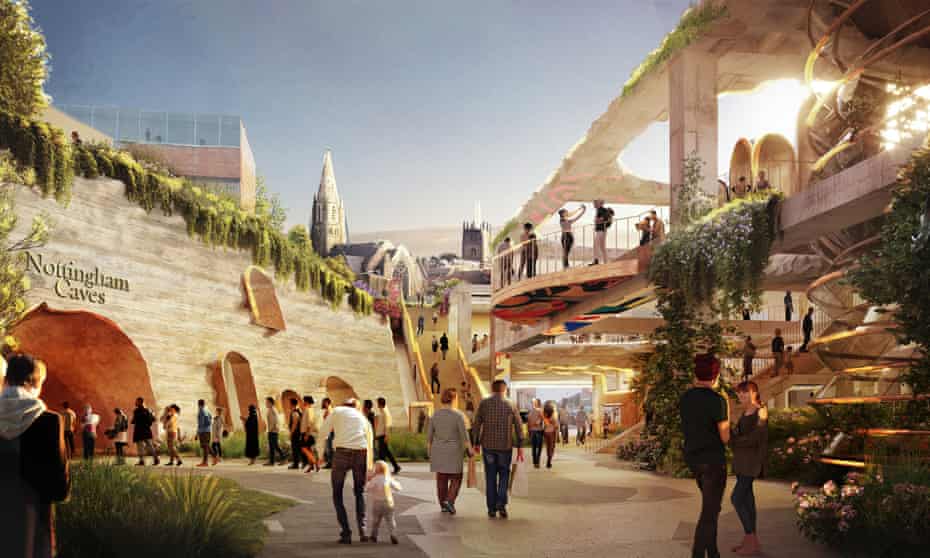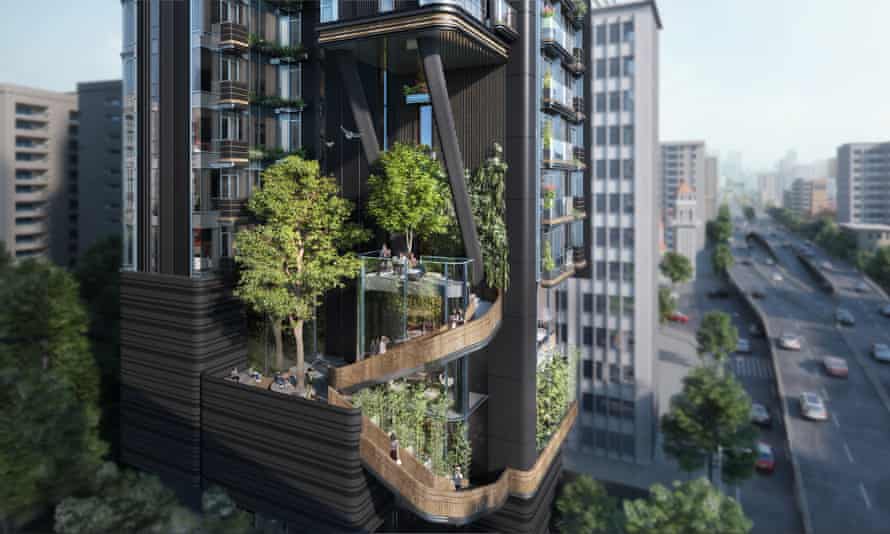Source >>>
‘Biophilic’ urban designers are bringing nature directly into our lives, improving the environment and our mental and physical health

Alice Fisher Sun 19 Dec 2021 07.00 GMT
As the year’s end approaches, cultural predictions for 2022 come thick and fast. In interiors and design, one trend is being flagged across the board, from Pinterest to Architectural Digest magazine – biophilic design. The idea, first coined in the 1970s, is that humans have an innate affinity with the natural world. Next year, biophilia seems set to become a major influence on everything from city planning and architecture to our furniture and the colour we paint our walls.
Defined by the psychologist Erich Fromm in 1973, biophilia gained traction when the American biologist EO Wilson wrote extensively about the concept during the 1980s and 1990s. Multiple scientific studies seem to confirm the hypothesis, suggesting that exposure to nature is good for human mental and physical health. There is evidence that it can speed hospital patients’ recovery, lower blood pressure, improve the immune response and increase office productivity.Advertisementhttps://dae4a4509138e0b4620ff2fd9481a97a.safeframe.googlesyndication.com/safeframe/1-0-38/html/container.html
As humans spend more time indoors than outside, often in built-up urban areas, biophilic design has emerged. This is essentially thinking up different ways to bring nature to people through changing the way we build and the materials we use for furniture and products. Biophilic design is also typically sustainable.
At the most straightforward lifestyle end of the spectrum, this means choosing natural materials such as wood or stone for flooring and furniture. Floral prints are a big trend for wallpapers. More people are building conservatories. But at the level of urban planning or architecture, biophilic principles change the fabric of the cities we live in.
“This is more than ‘putting the right plant in the right place’,” says MK Leung, director of sustainable design with the Hong Kong architects Ronald Lu & Partners (RLP). “Biophilic design involves natural forms, variations in daylight, airflow and temperature – ultimately, it means opening up buildings to nature. My attraction to it began when I realised the science behind it – it is about much more than aesthetically pleasing greenery, it involves biology, physics, psychology, sociology, and a myriad of mental and physical health aspects.”

Advertisement
Biophilic architecture is a key part of the construction boom underway in China and, like many Asian architects, RLP focuses on sustainable, biophilic designs such as the Zero Carbon Building, which features Hong Kong’s first urban native woodland. RLP is currently creating an apartment block called The Courtyard in Kowloon, due to open next year, which is designed as an urban forest with greenery in every view on every level and a sky garden of indigenous plants.
This isn’t just a trend for new builds. British cities which have their roots in the industrial revolution can still aspire to green shoots. Last week, the designer Thomas Heatherwick announced his plan to take the ruins of Broadmarsh, a part-demolished 1970s Nottingham shopping center, and turn it into a community garden, climbing wall and housing complex covered in plantlife.
Birmingham has been a member of the Biophilic Cities organization, an international group studying the value of nature in cities, since 2013. It is the first British city to complete an assessment of its “green infrastructure” and create a green living spaces plan, which places a value on all the natural spaces in the West Midlands conurbation and treats them as “natural capital”.
This includes plans to give access to its canal network to create a citywide trail and to promote jobs and pastimes connected to the local landscape.
“The idea of natural capital allows us to see that nature has massive value. It’s built up of all the services nature gives us: soils, fresh water, fresh air, biodiversity, health benefits, property price uplift, carbon absorption, flood risk reduction, and so on,” says Nick Grayson, Birmingham city council’s climate change and sustainability manager. “We have taken nature for granted and expected its ability to regenerate to be exponential. Cities are responsible for the consumption of 70% to 80% of natural resources, yet that has been invisible to the many people living in them.”
Birmingham is about to approve a plan to join Cities With Nature, a worldwide initiative to support cities working to create a sustainable urban environment, says Grayson. “Because the council is starting to understand nature’s true value and build that into its decision-making – it’s not just cutting the grass!”
Even if where you live doesn’t have a green plan or buildings with a copse on the third floor, there are ways to bring nature into your life.
Sam Peters and Deborah Spencer are the husband and wife team behind Planted, a zero-waste biophilic design event launched in 2020 to reconnect people and spaces with nature. As well as talks and installations, Planted showcases sustainable products and furniture. Besides the beautiful craft furniture by designer companies, there are bright ideas for the future such as water systems that encourage plants to thrive on available walls and surfaces and tiles which mimic natural stone, their textured surfaces providing homes for moss and insects. “Through peer-reviewed, evidence-based research, biophilic design enables us to build a commercial case and demonstrate to business leaders that enabling their workforce to access nature makes total business sense,” says Peters.
“As more people realize it is possible to design and construct buildings with nature in mind, we have no doubt that what is currently a trend will become the norm.”
On the most accessible level, acquiring plants as housemates will have a positive impact on your life. One person who really loves his “green friends” is Joe Bagley, a plant influencer who shares his Leicestershire home with more than 1,400 house plants.
“For me, the appeal is that the plant you have on your shelf is a living, breathing specimen. It interacts with the environment, sussing out local humidity levels, temperature levels. It’s similar to having pets. I love how my plants are at different points of their growth cycles. Most will be dormant now. Others, like my cyclamen, are pushing out some lush hot-pink flowers. It’s a pleasure to have a look around my small jungle to find that an orchid at the back putting on a show all by itself. The little things, right?”
Joy in the natural world is a great thing to achieve and finding harmonious ways to exist seems like a good plan. As Leung says: “The lessons from Covid-19 are stark: when we respect the natural world and its rules, there is enormous mutual benefit; when we ignore these rules, nature will not respect us.”
As 2022 begins, and you’re joining us from Indonesia, there’s a new year resolution we’d like you to consider. We’d like to invite you to join more than 1.5 million people in 180 countries who have taken the step to support us financially – keeping us open to all, and fiercely independent.
In 2021, this support sustained investigative work into offshore wealth, spyware, sexual harassment, labour abuse, environmental plunder, crony coronavirus contracts, and Big Tech. It enabled diligent, fact-checked, authoritative journalism to thrive in an era of falsehood, sensation, hype and breathtaking misinformation and misconception.
In 2022, we’ll be no less active, with a cluster of elections (France, Brazil, the US to say the least), economic pinch points, the next phase of the pandemic, the gathering climate emergency and the first ‘winter World Cup’ to keep us busy.
With no shareholders or billionaire owners, we can set our own agenda and provide trustworthy journalism that’s free from commercial and political influence, offering a counterweight to the spread of misinformation. When it’s never mattered more, we can investigate and challenge without fear or favor.
Unlike many others, Guardian journalism is available for everyone to read, regardless of what they can afford to pay. We do this because we believe in information equality. While others commoditize information, we seek to democratize it. Greater numbers of people can keep track of global events, understand their impact, and become inspired to take meaningful action.
If there were ever a time to join us, it is now. Every contribution, however big or small, powers our journalism and sustains our future. Support the Guardian from as little as $1 – it only takes a minute. If you can, please consider supporting us with a regular amount each month. Thank you.

